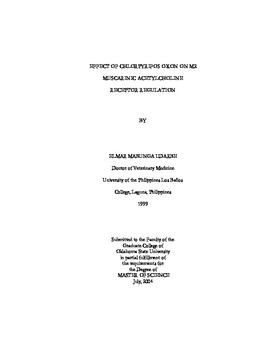| dc.contributor.author | Udarbe, Elmar Mabunga | |
| dc.date.accessioned | 2014-04-16T03:16:05Z | |
| dc.date.available | 2014-04-16T03:16:05Z | |
| dc.date.issued | 2004-07-01 | |
| dc.identifier.uri | https://hdl.handle.net/11244/9831 | |
| dc.description.abstract | A primary mechanism of tolerance to anticholinesterases is downregulation of muscarinic receptors. Activation of muscarinic receptors leads to receptor regulation via a sequential pathway involving desensitization, internalization and downregulation. The initial step in M2 receptor desensitization is phosphorylation by G-protein Receptor Kinase 2 (GRK2). Our laboratory previously noted that the potent anticholinesterase chlorpyrifos oxon (CPO) can inhibit agonist-mediated phosphorylation of human recombinant M2 receptors by GRK2 in vitro while paraoxon, another structurally-related anticholinesterase, had no effect. We hypothesized that CPO can disrupt M2 receptor regulation through direct binding to the M2 receptor at the GRK2-mediated phosphorylation site. To test the hypothesis, the binding of a radiolabeled muscarinic agonist and surface-selective antagonist were measured in cell lines expressing M2 receptors. Immunocytochemistry using M2 subtype-specific antibody was also done to determine the location of M2 receptors after treatments with carbachol and CPO in rat striatal neurons. In HEL 299 cells (fibroblasts expressing exclusively M2 receptors), the muscarinic agonist carbachol (CCH) reduced specific binding to the high affinity agonist [3H]oxotremorine-M (Oxo-M, 79%, 15 min exposure) and the extracellular surface-selective antagonist [3H]N-methyl scopolamine (NMS, 44%, 1 hour exposure), suggesting rapid agonist-induced desensitization and internalization. CPO (100 µM, 1 hour) had minimal effect on Oxo-M or NMS binding in the absence or presence of CCH. In CHO cells stably expressing M2 receptors (CHO-M2), CCH decreased NMS binding in a concentration dependent manner. CPO (100 µM) had little effect on its own but impaired carbachol-induced internalization in CHO-M2 cells. In primary neurons, M2 immunosignal was distributed diffusely throughout the cell. CCH (100 µM) led to internalization and concentration of receptors near the cell body. CPO (100 µM) had similar effects as CCH and combined exposure to both led to more extensive internalization. Our results suggest that although CPO may inhibit GRK2-mediated M2 phosphorylation, CPO differentially affects receptor regulation in different cells expressing M2 receptors. Direct binding of CPO to muscarinic M2 receptors could, however potentially affect receptor regulation pathways in vivo and contribute to cholinergic toxicity and tolerance to anticholinesterases. | |
| dc.format | application/pdf | |
| dc.language | en_US | |
| dc.publisher | Oklahoma State University | |
| dc.rights | Copyright is held by the author who has granted the Oklahoma State University Library the non-exclusive right to share this material in its institutional repository. Contact Digital Library Services at lib-dls@okstate.edu or 405-744-9161 for the permission policy on the use, reproduction or distribution of this material. | |
| dc.title | Anthropometric Measurements, Portion Sizes Ususally Consumed, and Body Image Perception in Native American Children | |
| dc.type | text | |
| osu.filename | Udarbe_okstate_0664M_1073.pdf | |
| osu.college | Center for Veterinary Health Sciences | |
| osu.accesstype | Open Access | |
| dc.description.department | Veterinary Pathobiology | |
| dc.type.genre | Thesis | |
| dc.subject.keywords | insecticides | |
| dc.subject.keywords | g-protein receptor kinase | |
| dc.subject.keywords | organophosphates | |
| dc.subject.keywords | desensitization | |
| dc.subject.keywords | internalization | |
| dc.subject.keywords | neurotoxicity | |
